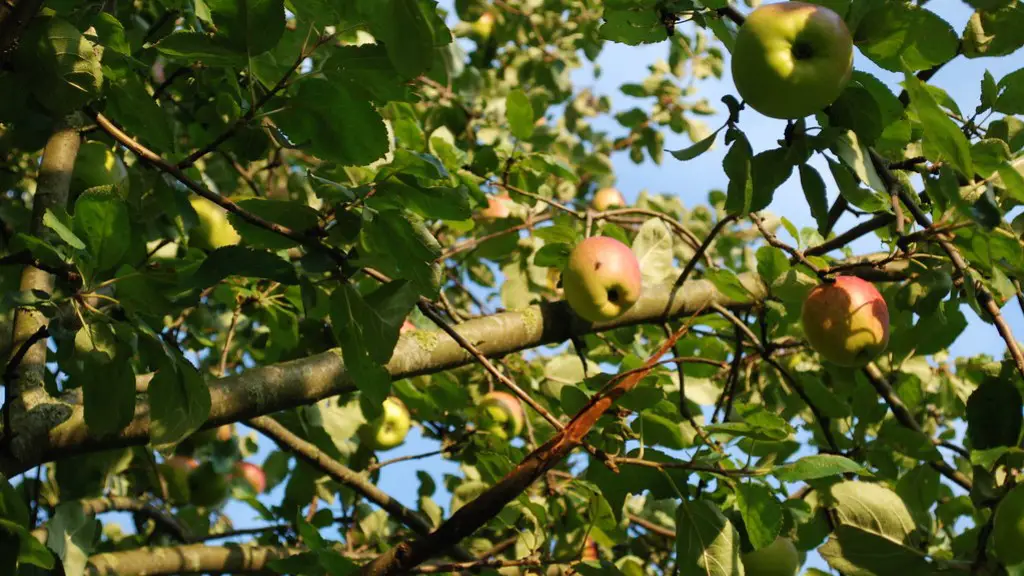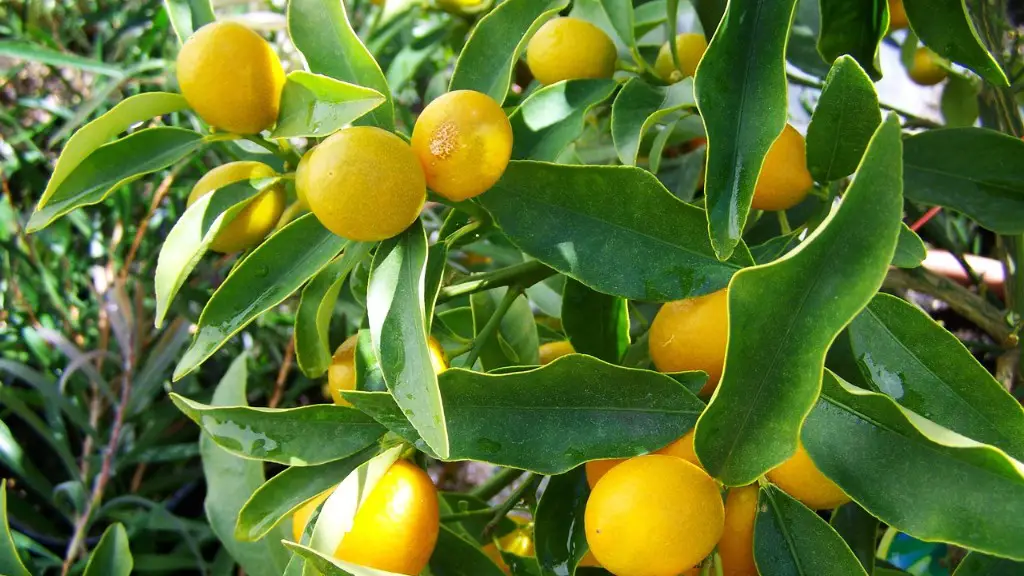Apple Trees that Pollinate Honeycrisp
Pollination is an essential factor when it comes to apple trees to produce the desired apple. For example, the Honeycrisp apple must be pollinated by another variety of apple tree to produce a bountiful crop of crisp, juicy apples. The types of apple tree that can be used to effectively pollinate a Honeycrisp include Braeburn, Gala, Golden Delicious, Rome Beauty, and Jonathan.
For successful pollination, it is important to understand the requirements of the Honeycrisp apple tree. Its bloom period, for instance, occurs at about the same time as the blooming periods of Jonathan, Golden Delicious, and Rome Beauty. Braeburn and Gala apple trees can be used for pollination, although their bloom period is one week later than the Honeycrisp.
In order for the Honeycrisp apple tree to be properly pollinated, both apple trees need to bloom at close to the same time. If the bloom period of the second apple tree is too far away from the Honeycrisp variety, then that tree will not be much use for successful pollination. Furthermore, the apple tree that is used for pollination should be healthy and disease-free, since diseases can spread quickly to nearby trees.
The best combination for successful Honeycrisp pollination is a combination of the Rome Beauty and Jonathan apple trees, as they are known to have overlapping bloom periods. Rome Beauty apple trees are also known to be resistant to some of the common apple diseases, such as scab, fireblight, and cedar apple rust. This makes the Rome Beauty a preferable pollinator for the Honeycrisp variety.
Another important factor to consider is the distance between the two different types of apple trees. Optimal pollination requires a distance of no more than 15m between the two apple trees. If they are too far apart, then the pollen may not reach the Honeycrisp variety, leading to a lower crop yield. However, if the two types of apple trees are too close, then cross-pollination may occur and this can lead to mixed results.
Finally, pollination needs to take place under the right environmental conditions. Windy, cold and wet conditions can reduce the effectiveness of pollination due to the flight of the pollen being hindered. Therefore, it is important to ensure that there are suitable temperatures and a light breeze when bees and other pollinators are out foraging.
Fertilization for Apple Trees
Fertilization is an important factor for the health and growth of an apple tree. It helps to ensure that the tree has enough nutrients to produce a bountiful crop of apples. The type of fertilizer used will depend on the soil pH, as well as the type of apple tree that is being fertilized. Generally speaking, organic fertilizers provide more nutrients and minerals than chemical fertilizers. Furthermore, they have fewer negative impacts on the environment.
When fertilizing an apple tree, it is important to start off with a soil test. This will help to provide an idea of the nutrients that are in the soil and any other relevant information that can help the grower appropriately fertilize the apple tree. A soil test will also allow the grower to decide on the right type of fertilizer. For example, if the soil test shows that the soil is low on potassium and phosphorus, then a fertilizer higher in these nutrients may be used.
Generally speaking, it is best to apply fertilizer to an apple tree when it is dormant. This will help to reduce the risk of burning the tree. The type of fertilizer and the amount used will typically depend on the size and age of the tree. For instance, a young tree will require less fertilizer than an established tree. It is also worth noting that it is important to evenly spread the fertilizer around the tree, and then use a cultivator to mix it into the soil.
The amount of fertilizer to use will also depend on the pH of the soil. If the soil is more alkaline, more fertilizer may be needed as the tree may be less likely to absorb it. However, if the soil is more acidic, then too much fertilizer may cause damage to the tree so it is important to pay attention to the soil pH. Furthermore, regular soil tests can help to ensure that the apple tree is receiving the right amount of fertilizer.
Finally, it is important to water the fertilizer into the soil after it has been applied to the tree. This will help to ensure that the fertilizer is absorbed by the apple tree’s roots. Furthermore, it will prevent runoff of the fertilizer from the rain or watering, which can also help to prevent fertilizer from leeching away from the tree and into nearby water sources.
Pruning for Apple Trees
Pruning is necessary for the health and productivity of an apple tree. It helps to control the size of the tree and encourages the production of larger and healthier apples. There are two main types of pruning that should be done on an apple tree: Formative pruning and annual pruning. Formative pruning helps to shape the apple tree and develop strong, healthy limbs that will produce larger apples. Annual pruning helps remove dead, diseased, or damaged limbs that can affect the apple trees health.
It is important to start pruning an apple tree while it is still young, as this will help to encourage strong, healthy growth. The main type of pruning to be done during the young years of an apple tree is formative pruning. This helps to girdle the tree and encourage the production of larger apples. A girdling is a technique used to shape the tree so that it has a strong and healthy shape.
During the formative pruning, the main goal is to keep the tree balanced with an open-center. This allows for air to move freely amongst the branches and encourage healthy growth. All branches that come out at a downward angle of less than 30-degrees should also be pruned back. This prevents the apples produced from being too close to the ground.
For annual pruning, a gardener should inspect the tree yearly and assess its health. Any dead, diseased, or broken limbs should be pruned back as soon as possible. Furthermore, pruning should be done in the winter when the tree is dormant. This helps to prevent the spread of disease, as well as encouraging the growth of larger apples.
Finally, it is important to be careful when pruning the apple tree. Too much pruning can lead to a decrease in the production of apples. Therefore, the gardener should pay attention to how much pruning is done. Furthermore, sharp pruning tools should always be used, as this helps to prevent damage to the tree.
Using Insecticide for Apple Trees
Insecticides are a common form of pest control for apple trees, as they help protect the apples from pests that can affect their growth and development. Insecticides can come in a variety of forms, such as liquid sprays, granules, and dusts. They can also be either systemic or contact insecticides.
Systemic insecticides are typically applied to the soil, where they are then absorbed by the apple tree’s roots. These insecticides will then travel to the branches and leaves, which can help to keep harmful insects away from the apple trees. Contact insecticides are applied directly to the affected areas of the tree and will only be effective on contact with the insect.
When using insecticides, it is important to read and follow the instructions provided. It is also important to ensure that the insecticide is suited for the type of pests that are affecting the apple tree. Furthermore, the insecticide should be applied at the right time of the year, as certain insects will only be active during certain parts of the year.
Insecticides also need to be applied in the right amount, as applying too much can be harmful to the apple tree, as well as the environment. Furthermore, insecticides should not be used during the bloom of the apple tree, as the chemicals can affect the pollination of the flowers.
Finally, it is important to remember to wear the appropriate clothing when using insecticides. This includes gloves and a face mask to protect oneself from the chemicals. Furthermore, it is important to clean any tools used to apply the insecticide, as this can help to prevent the spread of the insecticide to other areas.
Harvest Time for Apple Trees
Harvest time is an exciting time for many apple tree growers. It is the time when all of their hard work, in terms of planting, caring for and nurturing the tree, comes to fruition. As such, it is important to know when the optimal time for harvesting is. This will depend on the type of apple and the culture in which the apple tree was grown.
The general rule of thumb is that apples should be harvested when they are ready. This includes being the right size and color, as well as having the right texture. Furthermore, the seeds should also be mature, as this will ensure that the apple can reach its peak flavor. For example, Honeycrisp apples should typically be harvested when they are a light green color.
It is also important to know what time of the year is the best time to harvest apples. For most apple trees, the harvesting period occurs in the late summer and early fall months. However, there are also some varieties of apple that can be harvested earlier, such as early season apples. Thus, it is important to check the season of the apples before harvesting them.
It is also worth noting that apple trees may have different harvest times depending on where they are grown. For example, apples grown in the northern part of the United States tend to be harvested earlier than those grown in the southern part of the country. Furthermore, apples grown in warm climates may ripen faster than those grown in cooler climates.
Finally, it is important to ensure that the apples are harvested at the right time. Too early, and the apples will not develop their full flavor and sweetness. Too late and the apples may become overripe and may fall off the tree quickly. To help determine when the apples are ready for harvesting, it is important to monitor the ripening progress with constant observation.
Storing and Eating Apples
Once an apple tree has been harvested, the apples need to be stored correctly to ensure that they maintain their flavor and freshness. The best way to store apples is to place them in a dark, cool, and dry place, such as a root cellar or basement. Apples should also be stored away from other fruits, as other fruits may cause the apples to spoil.
It is also important to check the apples regularly for signs of spoilage, such as mold or discoloration. If affected, the affected apples should be removed from the batch and discarded. Furthermore, unwashed apples should not be stored with washed apples, as the pesticide residue can transfer to the washed apples.
When it comes to eating apples, there are a variety of ways to enjoy them. Apples can be eaten raw, cooked, or turned into a variety of dishes, such as pies, cakes, or sauces. Furthermore, apples can be used in baking, as they add a sweet taste to many recipes. Apples are also a great source of vitamins, minerals, and fiber, which makes them a nutritious snack choice.
Finally, one of the best ways to enjoy apples is to make cider. This is a popular drink that is made from the juice of apples. It is a great way to enjoy the flavor of apples, as well as getting some of the beneficial vitamins and minerals that apples provide. Furthermore, it is a great way to enjoy the apples from an apple tree all year round.


